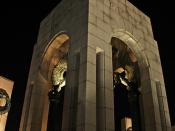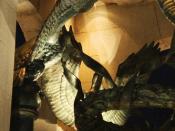Art has been a part of our life for as long as humanity has existed. For thousands of years people have been creating, looking at, criticizing, and enjoying art. The definition of art has changed almost every day since the beginning of time. No one has been able to properly define art to all perspectives. "Art refers to all creative human endeavors, excluding actions directly related to survival and reproduction. From a wide perspective, art is simply a generic term for the creative impulse, out of which sprang all other human pursuits such as science via alchemy, and religion via shamanism." (Wikipedia, 2004) The bottom line is that art can be almost anything, which leads us to Thomas Hoving's definition of art in the broadest possible way. "Art is when anyone in the world takes any sort of material and fashions a deliberate statement with it." Hoving (Page 3 Para.
6) Another popular disagreement is what constitutes art and good art vs. bad art. With both there is no single definition that is widely agreed upon. A common and well known view is that art requires a creative and distinctive perception of both the artist and intended audience. The work of art must also possess a sense of quality in order to be considered "good art." The following websites provide insight to how dance, visual arts, music, film, television, radio, folk art and theatre are considered art.
1) Dance - http://www.artlex.com/ArtLex/d/dance.html
"Dance is an art form consisting primarily of movement of the human body. Usually it is a series of rhythmical movements of the feet and other body parts performed in time to music." (Artlex 2004) Dancers use their bodies as the medium. Just as there are forms in art; paintings, sculptures, etc., there are different forms of dance,


